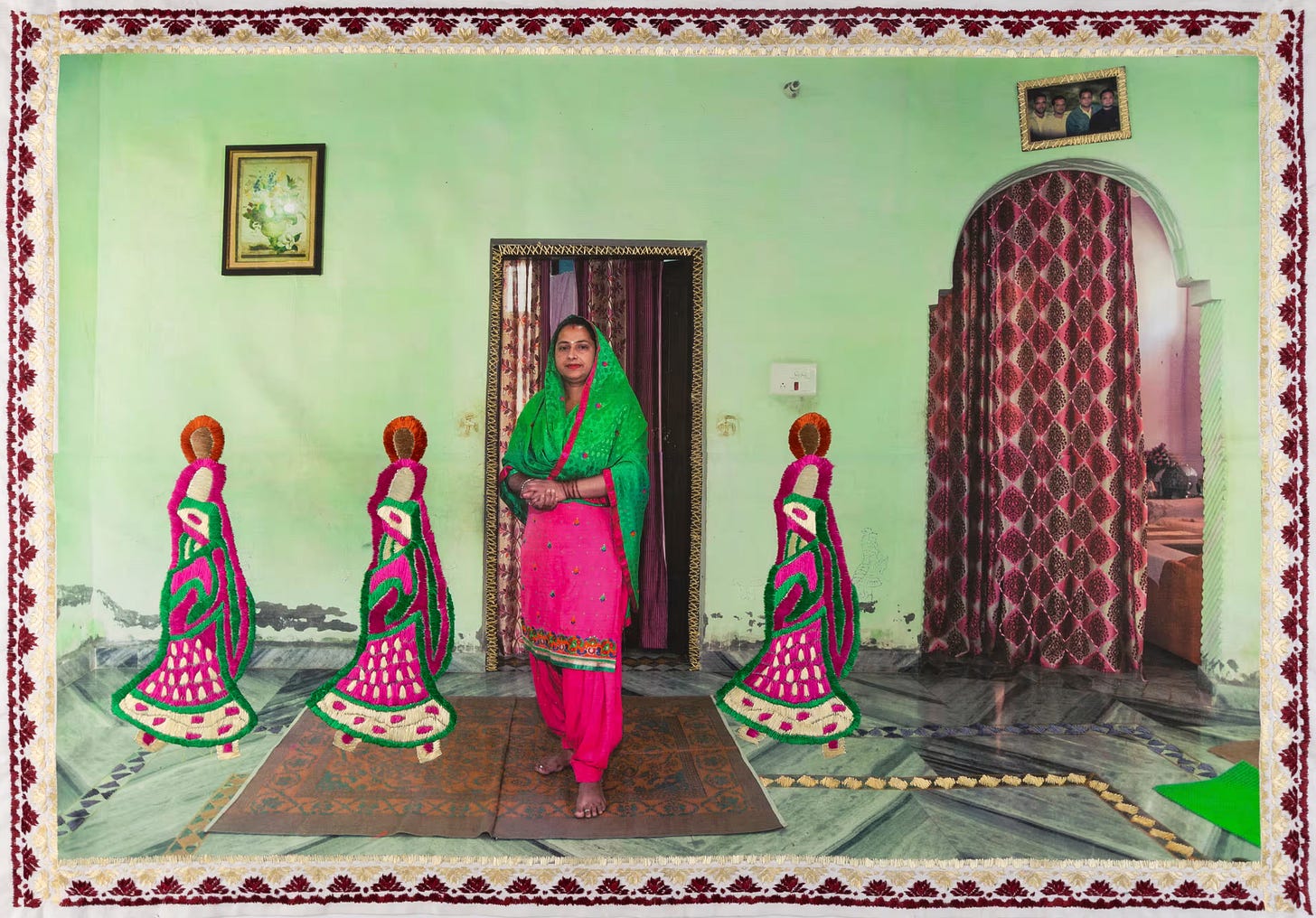US women are now more likely to marry a less-educated man than vice versa.
And Indian women, many of whom are abuse survivors, are embellishing their own portraits with traditional needlework.
Good morning.
Monday has arrived, crisp and composed, as if to quietly suggest we get our act together. The slow sprawl of winter weekends has vanished, and in its place: tempo, texture, and a calendar that doesn’t believe in blank space.
My own weekend unfolded in vignettes. Friday evening’s clothing swap felt both charmingly communal and a clever way to refresh a wardrobe without courting regret—three silk scarves and two summer jackets found their way into my bag, all while leaving behind far more than I brought. Saturday morning brought balance—sweat, steam, and a few deep breaths in a sauna before the city called me back. A group of us joined with tens of thousands of others at the Hands Off protest followed by a birthday lunch that stretched into early evening, and, later still, another birthday soirée that ended with karaoke and questionable harmonies.
Sunday moved more gently. I let the morning pass in soft focus, then wandered through the Art Institute with friends visiting from out of town. The quiet hum of galleries and conversation provided just the right note on which to end a whirlwind two days.
Now, back at my desk, coffee in hand, I find myself ready to begin again. Here’s to a new week: composed, caffeinated, and just the right amount of curious.
In today’s letter: child marriage in Nepal, women in tech in Turkey, Venice’s ancient engineering, newly born Galapagos tortoises, and a Paloma Wool store in New York.
Nepal’s effort to eradicate child marriage is at a crossroads. A parliamentary recommendation to lower the legal marriage age from 20 to 18 has stirred fierce debate in a country where tradition, caste hierarchy, and economic fragility conspire against girls’ futures. Though the change is pitched as a practical fix to legal grey areas, rights groups warn it would undo years of progress and put millions of girls at greater risk of early marriage, abuse, and lost opportunity. The numbers are stark—over five million child brides, 37 percent of women under 30 married before 18—but the human stories are more revealing. Girls like Bali, married at 13 and confined to domestic servitude for five years, and Khima, wed at 17 to ease her family’s financial burden, offer chilling insight into what’s at stake. While some, like Bali—now a truck driver—fight to reclaim agency, too many others are still navigating a future not of their own choosing. Nepal may argue the change reflects “social realities,” but critics say it's a retreat from its commitment to end child marriage by 2030—and a quiet concession to those who benefit from keeping girls in the margins.
In the political vacuum following the fall of Bangladesh's authoritarian leader, Islamist extremists are capitalizing on the country's instability, asserting control over everything from women’s bodies to public spaces. In one town, a local mosque leader forced the cancellation of a women’s soccer match, calling it "indecent," while in Dhaka, radical groups demand death penalties for those who disrespect Islam. As the interim government struggles to balance democracy with religious extremism, women and religious minorities, particularly Hindus and the Ahmadiyya, find themselves increasingly vulnerable. What began as a backlash against secularism has now evolved into a wider push for an Islamic state, with even the largest Islamist party, Jamaat-e-Islami, eyeing the long-term political gains. In this turbulent landscape, the question remains: Can Bangladesh preserve its cultural diversity and secular values, or will it succumb to the forces reshaping the region’s political and religious landscape?
In Turkey's tech sector, where women account for less than a quarter of the workforce, persistent sexism drives many female coders to seek opportunities abroad. The Kadin Yazilimci (women coders) group, established in 2013, has been pivotal in challenging gender-based discrimination, but the industry remains largely male-dominated. Women in tech often face marginalization, with many pushed into lower-status roles or overlooked entirely. Political pressures on women’s societal roles and restrictive policies have further fueled the brain drain, particularly among young professionals.
More than 300 children are dead and at least 600 injured since the Israeli offensive in Gaza restarted two weeks ago, according to UNICEF.
The latest update of the “Women’s Power Index” from the Women and Foreign Policy program reveals that global progress toward gender parity in political leadership has stagnated. With an average score of 29 out of 100, the gap in political representation remains wide across 193 UN member states. While countries like Canada, the UK, and Moldova have made notable strides, others such as Mozambique and Rwanda have seen declines. Iceland remains the leader with a score of 86, while the U.S. stands above the global average (but still very low) at 35. The number of female heads of state has grown since WWII, but recent years have seen a slowdown, with just 25 countries now led by women. Similarly, women’s representation in national cabinets has dropped significantly, with only nine countries achieving gender parity in their cabinets—down from 15 last year. Despite some progress, the overall trend suggests that the road to gender parity in politics remains long and uneven.
US women are now more likely to marry a less-educated man than men are to marry a less-educated woman. “A growing body of research suggests that women are indeed marrying less-educated men simply because that’s who is available—not necessarily because of changing preferences.” This was a significant topic of conversation at our long lunch this weekend…

In Nā́rī, photographer Spandita Malik stitches together art and activism, allowing women across India, many of whom are abuse survivors, to embellish their own portraits with traditional needlework. Take, for example, Praween Devi, who, instead of erasing the photograph of the men in her home, embroidered three women in pink and green, making a bold statement about reclaiming space and defying patriarchal norms. The act of embroidery here becomes more than just craftsmanship; it’s a quiet revolution, a reassertion of agency in a world that often silences these women. What strikes me most is how Malik shifts the power dynamic of photography—these women aren’t just subjects; they are artists, rewriting their stories one stitch at a time. In a world where silence is often imposed, these women are finally speaking, with thread as their voice.
New research reveals that the average person could be 40% poorer if global temperatures rise by 4°C, a stark contrast to previous models that underestimated the economic toll of climate change. The study, which enhances traditional economic models by factoring in extreme weather events and supply chain disruptions, highlights the devastating consequences of inaction. Experts warn that the cascading impacts of rising temperatures—ranging from droughts to floods—will affect global supply chains and economies, making it crucial for nations to retool their climate policies and urgently reduce emissions. The study underscores the need for a more nuanced understanding of climate risks in shaping economic strategies.
In a historic first for the Philadelphia Zoo, a pair of nearly 100-year-old, critically endangered Galapagos tortoises, Mommy and Abrazzo, have become first-time parents. CUTE. Four hatchlings, weighing just 70 to 80 grams each, have been quietly growing behind the scenes in the Reptile and Amphibian House since their first egg hatched on February 27. Mommy, one of the most genetically valuable members of her species, arrived at the zoo in 1932, and the zoo’s goal is for these hatchlings to contribute to a thriving population of Galapagos tortoises in the future. A public debut and naming contest are planned for April 23.
India is bracing for an intense heatwave this summer, with above-normal temperatures expected nationwide. The India Meteorological Department warns that many states will face more heatwave days than usual, exacerbating the already deadly toll of extreme heat. Last year saw record-breaking temperatures, including a scorching 50.5°C in Rajasthan, and hundreds of heat-related deaths. As agricultural sectors struggle with water shortages, experts warn that the country’s underreporting of heatstroke fatalities may mask the full impact. With rising greenhouse gas emissions and unchecked industrialization, heat waves are forecast to become more frequent, posing a growing threat to India’s future.
Venice, a city 1,604 years old, stands as a testament to the ingenuity of ancient engineering, its foundations a marvel of resilience. Built atop millions of wooden piles—crafted from larch, oak, alder, pine, spruce, and elm—pounded into the soft ground with precision, Venice’s architectural legacy has endured for centuries. These piles, once hammered by skilled ‘battipali’ to the rhythm of traditional songs, anchor buildings from the Rialto Bridge to the San Marco Basilica, holding fast in the mud, water, and soil. This system, developed before the advent of reinforced concrete and steel, relies on the friction between tightly packed wooden piles and the soil, a technique that dates back to Roman times. Despite the pressures of time and modern development, the city’s foundations remain intact, offering a glimpse into the resourceful spirit of its ancient builders. While modern materials have replaced wood in contemporary construction, Venice’s enduring wooden foundation—a blend of nature’s forces and human ingenuity—continues to defy the centuries, standing as an unparalleled feat of ancient geotechnical engineering.
There are countless reasons to covet a Swiss passport, and among the most compelling is undoubtedly its exquisite design—an elegant blend of functionality and artistry that reflects the nation’s commitment to precision and aesthetic excellence.
Cinema’s first family - the Coppolas - have a selection of hideaways in Belize, Guatemala, Argentina, Italy, and the US that offer a luxurious blend of cinematic escape and immersive nature. For example, at Blancaneaux Lodge in Belize, there is a sprawling organic farm cultivated using ancient Mayan agricultural practices. I did not know these existed until today, but they look beautiful. Has anyone visited?






